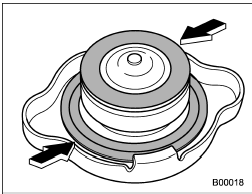Checking the coolant level

Never attempt to remove the radiator cap until the engine has been shut off and has cooled down completely. Since the coolant is under pressure, you may suffer serious burns from a spray of boiling hot coolant when the cap is removed.

1) “FULL” level mark
2) “LOW” level mark
Check the coolant level at each fuel stop.
1. Check the coolant level on the outside of the reservoir while the engine is cool.
2. If the level is close to or lower than the “LOW” level mark, add coolant up to the “FULL” level mark. If the reserve tank is empty, remove the radiator cap and refill as required.

3. After refilling the reserve tank and the radiator, reinstall the cap and check that the rubber gaskets inside the radiator cap are in the proper position.

Never attempt to remove the radiator cap until the engine has been shut off and has cooled down completely. Since the coolant is under pressure, you may suffer serious burns from a spray of boiling hot coolant when the cap is removed.

• Be careful not to spill engine coolant when adding it. If coolant touches the exhaust pipe, it may cause a bad smell, smoke, and/or a fire. If engine coolant gets on the exhaust pipe, be sure to wipe it off.
• Do not splash the engine coolant over painted parts. The alcohol contained in the engine coolant may damage the paint surface.
See also:
Safety
As of this writing, the all-new Impreza hasn't been crash-tested. The WRX
retains its Top Safety Pick designation from the Insurance Institute for Highway
safety, having earned top scores of Good ...
When CD is in the player (type C and D)
Each brief press of the button
changes the modes in the following
sequence.
*: For type C audio, “BT-A” is displayed.
When the CD mode is selected, the player
will start playback. ...
Leather seat materials
The leather used by SUBARU is a high quality natural product which will retain
its distinctive appearance and feel for many years with proper care.
Allowing dust or road dirt to build up on the sur ...


